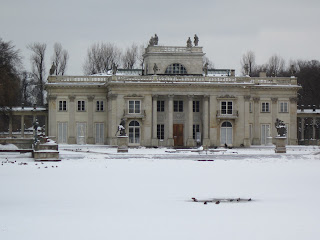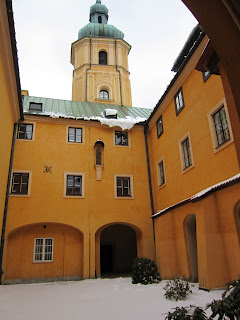Warszawa
Spent last weekend -- February 17th to 19th in Warsaw. I had a meeting with the Fulbright staff who run the Fulbright program in Poland -- wonderful people. Met three young women who were working on their doctoral degrees in various topics related to Poland and/or Jews or Jewish women in Poland.
Terrific lunch with them and all the Fulbrighters (Jackie is still raving about her veal chops).
Checked into our hotel --Mamaison Residence Diana -- beautiful studio apartment - at $64 a night.
Saturday began with coffee and sweet cream-filled rolls before our scheduled tour. We signed on for what we though was a bus (van) tour and turned out to be mostly on foot. Tour began in Lazienki Park which is a massive garden area south of Old Town Warsaw. Park Houses Lazienki Palace, Monument to Chopin, Temple of the Sibyl, Threatre on the Island, Myslewicki Palace, and Belweder Palace (pictures in that order below)
After walking through this hugh park (about 90 minutes) it was back in the van to follow the "Royal Route." The street Nowy Swiat (New World) leads toward Old Town and as it does it merges into Krakowskie Przedmiescie and the beauty begins. Staszic Palace (Polish Academy of Sciences) with statue of Copernicus, Church of the Holy Cross, Warsaw University, Church of the Visitation, Namiestnikowski Palace (President's Residence), Carmelite Church and Adam Mickiewicz.
Krakowskie Przedmiescie ends in Old Town at Zygmunt's Column and the Royal Palace (Zamek Krolewski). Places of significance in Old Town are Church of St. Martin, Cathedral of St. John, Jesuit Church, Old Town Square (Rynek Starego Miasta), and the Barbican & City Walls.
Because we were short on time, we had to chose between New Town and the Jewish Ghetto. Sorry New Town but the Jewish Ghetto is a must see. Created by the Nazis in 1940, Jews were "walled-off" from the rest of Warsaw and in 1942 the Germans began to liquidate the ghetto deporting 300,000 to Treblinka. The Ghetto Uprising began in 1943 and lasted one month. The Nazis razed the whole area after they surpressed the uprising. Pictures are of: Umschlagplatz (railway siding from which Jews were loaded into cattle cars and dispatched to death camps, Monument to the Heroes of the Ghetto (pictures 2 & 3), ZOB Bunker and marker (pictures 4 & 5)(where hunderds of Jews are buried -- no one knows exactly how many -- committed suicide rather than go to the death camps).
Obviously, these pictures were taken over our two and one-half days in Warsaw.
The train ride from Wroclaw to Warsaw and back was five hours each way but it was clean and comfortable and relatively inexpensive. The weather in Warsaw last weekend was snow with a mixture of snow and rain on Sunday.
Great experience!
Wonderful city!












.JPG)














No comments:
Post a Comment